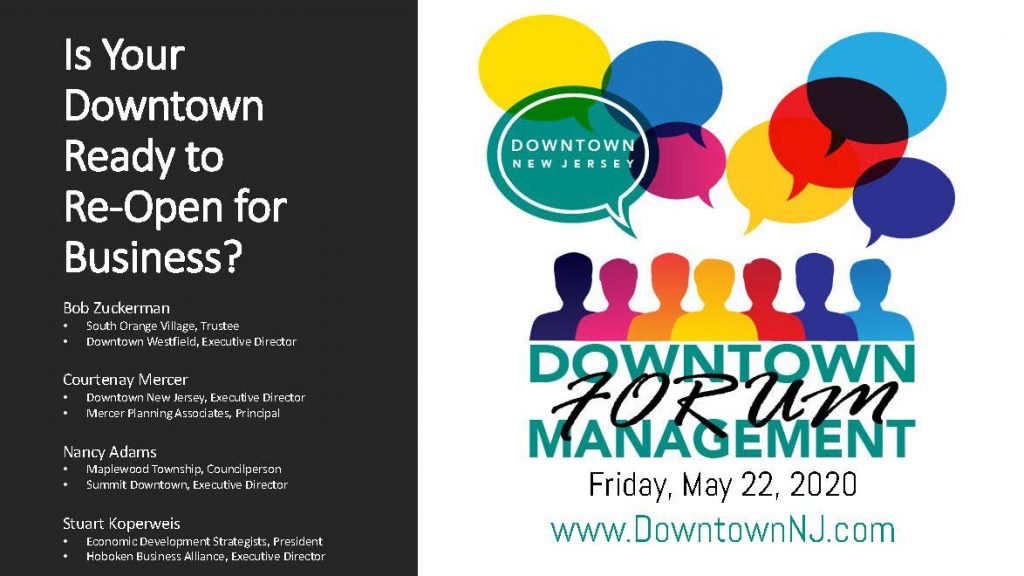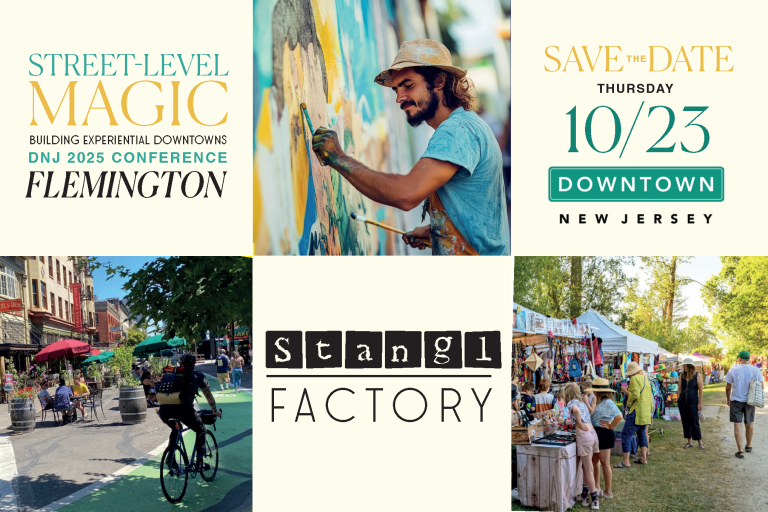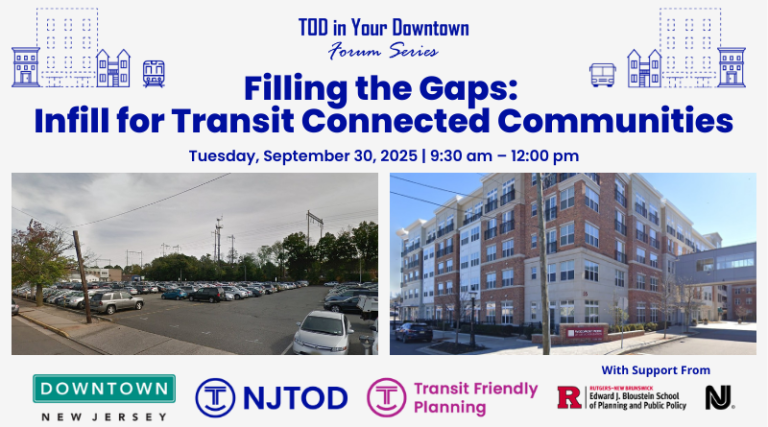Is Your Downtown Ready to Re-Open for Business?
Courtenay D. Mercer, PP, AICP
Executive Director, Downtown New Jersey
Rachael Thompson Panik
Associate Planner, Mercer Planning Associates
May 22, 2020
Downtown New Jersey provided a series of virtual opportunities for downtown managers, economic development professionals, and public officials to exchange ideas about best practices related to downtown economic development in light of the COVID-19 crisis.
Towns should be looking at their ordinances and permitting processes now to ensure they fully support their businesses’ ability to adapt to social distancing expectations. Some communities are looking at street closures, enabling expansion of restaurant/retail into parking lots, relaxing sign rules, revising on-street parking rules to enable pick-up and delivery, etc. Others are also working to revise use restrictions to provide flexibility in filling anticipated vacancies. The discussion was led by Bob Zuckerman, President of Downtown New Jersey and Executive Director of Downtown Westfield with input from Courtenay Mercer, Executive Director of Downtown New Jersey; Nancy Adams, Councilperson in Maplewood; and Stuart Koperweis, Executive Director of Hoboken Business Alliance.
Watch Video:
Jump to Examples/Resources
Policy Update
Downtown New Jersey’s Executive Director, Courtenay Mercer, began the forum with an of her participation on the Main Street Committee of the Governor’s Restarting Advisory Council. Recent updates include:- The Governor signed legislation on May 15th that allows pick-up and delivery of mixed drinks.
- Curbside pick-up and delivery for non-essential businesses began on Monday, May 18th.
- On May 19th, archery ranges, batting cages, golf driving ranges, horseback riding, shooting rangers, and tennis clubs were allowed to reopen.
- NJ will be allocating $50 million of its CARES Act funding to small businesses in, so stay tuned for more information.
Zoning Roadblocks
Bob Zuckerman is a trustee of South Orange Village and the Executive Director of Downtown Westfield. In addition, Bob is the President of the Downtown New Jersey Board of Directors and a small business owner. Bob shared a major accomplishment from his previous role as the South Orange Village Alliance Executive Director. While in this position, he and his team conducted an in-depth zoning review with the intention of making the code more amenable to more small businesses. By identifying roadblocks to desirable businesses within their downtown, they were able to create an amendment to the ordinance related to allowable uses in different areas of downtown.
Bob shared a story about what zoning roadblocks look like in practice. A restaurant relocated. In a neighboring town, because a new proposed restaurant space falls within 150 feet of a residential plotline, it requires of zoning board review despite being a conforming use. This creates a 3-month planning process for something that is likely not an issue. Some businesses might decide this is too much of a burden, and could decide to locate to a more business-friendly town so they can open sooner.
For downtowns generally, it is crucial to identify parts of ordinances that may be a hinderance to new businesses. An unfortunate reality of the COVID19 pandemic is that many small businesses shutting their doors for good. Despite this sobering truth, municipalities must remove all barriers for new desirable uses to enter the market in place of closed businesses.
Tactical Urbanism
Courtenay Mercer is Principal at Mercer Planning Associates and Executive Director of Downtown New Jersey. Courtenay shared examples of “tactical urbanism” style solutions that can be put into place to help towns reopen while still maintaining social distancing and limited contact requirements. Courtenay’s recommendations are summarized below:
- Convert actuated signals: Pedestrian crossing signals are often push button actuated, meaning they require pedestrians to push a button near the pedestrian head light in order to get a crossing signal. Where possible, consider converting actuated signals into passive detection signals, or signals that can detect pedestrian movement without pushing buttons, therefore eliminating contact at the signal.
- Dedicated delivery/loading zones: Create safe places for delivery and curb-side pickup in front of businesses. Installations do not have to be permanent in nature; instead, signs and cones can be used to section off parking spots or places in the street for safe pick up.
- Pop Up Bike Lanes: Close or limit traffic in a single lane of a multilane road to create more places for people to bike and walk, as more people are using the sidewalks and traveling by bike in many places. The installation can be temporary; the lane could be in place for a period of weeks or months, or just at certain times (e.g. nights and/or weekends). Simple materials, like cones and signage, can be used to create this place on the street.
- Open Streets and Ciclovia Plans: Make us of existing routes and plans. Winnipeg, for example, designated four streets as bicycle/active transportation routes, limiting motor vehicle traffic in each to one block. Under normal circumstances, these routes are in place on Sundays, from June to September.
- Close or limit through traffic: Some streets are seeing as great as 70% reduction in daily traffic counts, so consider reprioritizing active travel instead of automobile travel along routes that are close to major destinations, like parks, or that connect major destinations to neighborhoods, or perhaps in the central business district. This can be done with paint and barriers.
- Newark Avenue Pedestrian Mall: Jersey City created safe places for people to walk uninterrupted by vehicular traffic. At first, the pedestrian mall just operated on weekends, but now the mall is becoming permanent and being expanded. In the near future, infrastructure quality will be updated to make it a permanent installation.
- Expand Pedestrian Realm in Congested Areas: Some sidewalks are not wide enough to accommodate the rise in foot traffic during the pandemic, so there is need to create new spaces for people to walk. This can be done through different levels of tactical urbanism, using simply barriers, or through paint and raising edge of the pavement to sidewalk height.
- Outdoor Dining: As restaurants open, they are installing new solutions to make sure customers can eat and drink at a safe distance from one another. Worldwide examples include further spaced out tables, plexiglass installations between booths and tables, and even private gazebos for each table, creating privacy and separation from other patrons. While there are no official protocols for restaurants in NJ yet, but it is possible that restaurants will need to reduce to 50% capacity, possibly down to 25%.
- Parking lots: Create comfortable and inviting spaces in parking lots for customers to spread out and eat by using tents or other semi-enclosed structures. The same approach could be used for other businesses outside of dining, like gyms and studios.
- Parks, plazas, and streets: Allow nearby restaurants to spill out on the sidewalks, streets and plazas to create more space for customers.
- Parklets: Consider removing single parking spaces in front of businesses to create a small patio/outdoor place for people to eat and drink. Information about to safely design and install parklets can be found in the North Jersey Parklet Handbook.
It can be difficult to make some of these tactical urbanism style changes under existing zoning and regulations. In particular, some are concerned about permit fees for outdoor dining both from the municipality and the Division of Alcohol Beverage Control (ABC). Courtenay shared some examples on how to navigate these barriers from towns and cities in New Jersey.
- Brick: The township received a one-year outdoor dining permit approved by Zoning Officer. This permit does not need to go to zoning board, saving time and money.
- Point Pleasant Beach: The municipality is working with County to build six parklets along Arnold Avenue and Bay Avenue. Each street will convert 2 parking spots each, and the town is partnering with the County, as these streets are county owned.
- Fair Lawn: Leaders are working on creating outdoor dining space and walkable streets.
Tactical Urbanism Resources
Maplewood Best Practices
Nancy is a Councilperson in Maplewood Township and the Executive Director for Summit Downtown. Maplewood is taking approaches that will save time and allow the township to respond rapidly to concerns. Since some of the changes they need to be made are not necessarily permanent and need to be flexible in timing, they are choosing to make changes through resolution, not through ordinance. This saves process time, allowing necessary changes that support downtowns to be made quickly and effectively. Outdoor dining is typically only allowed in front of own business, but now businesses in Maplewood are allowed to expand beyond 100’ in each direction with approval from neighboring stores. Instead of considering major street changes, look at parking. Take away spots without closing streets to allow for flexibility, and approach each of these needs on a case by case basis. Nancy warns those considering similar approaches to be sure that the resolution contains baseline requirements, such as ADA compliance (e.g., 4 feet of clearance on the sidewalk). Also, when taking away parking spaces for dining and retail use, try to use spaces that are not being used presently first, such as transit spaces (assuming coordination is allowed) or public parking lots.
Hoboken Best Practices
Stuart Koperweis is the president of Economic Development Strategists and the Executive Director of Hoboken Business Alliance.
Stuart and his team worked with the City of Hoboken planning staff to pull together code that will help businesses reopen. Adopted by resolution, the amendments include accommodations for sidewalk café and open streets uses as a part of a gradual reopening plan. For sidewalks, the amendment allows applicants to waive the approval process in 2020 for sidewalk café expansion, as well as allowing for expedited approval. If fees have been paid for this accommodation already, they will be credited to 2021.
Regarding street uses, the amendment allowed for parklets and StrEATERY spaces, which are daily shared public spaces that temporarily convert curbside parking into an area for convening and/or outdoor dining. The amendment encourages StrEATERIES to be shared among adjacent businesses. There is a fee associated with creating this parklets in order to offset the lost parking meter revenue. The Hoboken Business Alliance is contemplating funding and installing some of the parklets themeselves.
Metuchen Best Practices
Councilperson Jason Delia of Metuchen shared some initiatives they are doing in their community.
- Significantly expands outdoor capacity for restaurants and retail sales including use of sidewalks, the Plaza, public parking lots, on-street parking spaces, private alleyways, private parking lots, and other private outdoor spaces;
- Closes New Street (between Main and Pearl) to vehicles every Friday at 4pm through Sunday at 11pm to allow for expanded outdoor dining and retail opportunities;
- Allows restaurants without liquor licenses to permit the consumption of alcoholic beverages by customers while dining in the newly approved areas;
- Requests that the Division of Alcohol and Beverage Control permit restaurants with liquor licenses to extend their premises to include the newly approved areas; and
- Mandates that businesses comply with all CDC and State guidelines to ensure the safety of customers and employees.
Discussion
Pop up shops: Has anyone allowed pop-up shops? Does this require special permitting or fees?
- This has not been an issue so far because it is dealt with under the existing zoning requirements. Some municipalities require a fee for this type of thing, but Nancy encouraged easing up on fees and permitting to allow more opportunity for retail to take advantage of pop up shops.
Municipal lots: How do you prioritize which businesses can use municipal lots?
- Downtowns can lean on improvement district to facilitate scheduling, but they should take advantage of existing scheduling platforms like Slyreply to help scheduling go quickly and efficiently. Generally, scheduling of existing spaces should be a balancing act to make the best use of public and private spaces. It is key to preserve curbside pickup for those businesses who are using that as their main source of revenue at the moment. A good strategy would be to assess businesses’ needs on a case by case basis and think about their uses and the type of revenue they make to figure out who needs which spaces the most. And finally, consider looking through an equity lens as those spaces are allocated.
Fees and insurance: What do downtowns do about fees?
- Many cities are considering waiving outdoor dining fees for the season to better enable socially distant customer service.
- Maplewood is requiring $1 million insurance policies for those using public space to protect the town in case of unforeseen problems.
Closing Main Street: Is anyone closing their main street for outdoor dining and eliminating parking spaces?
- Hoboken Business Alliance can petition to close the street to create a pedestrian mall on Thursday evenings through Sunday afternoons for both dining and retail.
Paid parking: What municipalities are considering bringing back paid parking in 2020, since most are not collecting payment for parking now?
- Some experts say downtowns should not charge for the remainder of 2020.
County coordination: Has anyone worked with the County to use county streets to expand into the roadway?
- Point Pleasant Beach is in negotiations.
Communal tables: Will closed streets make use of communal tables for everyone to use, if so, what is the procedure to make sure they are sanitized? Are BIDs buying these tables?
- Maplewood has been coordinating with improvement districts purchase tables for communal use. The city has purchased them, but they are waiting on permission from the governor before putting them out. In terms of cleanliness, this is a big logistical use, and some have used improvement districts to pay for sanitation in the past. Another option could be the city supplying publicly available wipes for cleaning the tables themselves before use.
- Some vendors that participants have looked into:
Alcohol: With on-street dining, will businesses be able to provide alcohol?
- It depends on the business at present. If it is BYO, then typically this is allowed assuming that the local ordinances/resolutions allow for it. But for businesses that hold a liquor license, the ABC has yet to decide on next steps on its rules for extension of premise.
- Maplewood had a call with ABC on Monday, and they are hoping to due extension of premise through the state ABC. All that will be required is Police Chief and Clerk to approve it. It is unclear what fees will be included or how long the turnaround time will be. This information will come out ASAP.
Reallocating BID funds:
- Some municipalities are considering reallocating funds that were going to be used to host events to create a reopening funds. In some places, people have been asking for donations to help reopening funds.
- Some are creating reopening kits that would include banners and branded masks that would support businesses.
Some Neighborhood Preservation Programs communities are launching technical assistance grants supported with state funding. Details are forthcoming, but CBDG funds can be also used for grants for small businesses. Helpful links: Seattle Times; CBDG help (second from the bottom)



